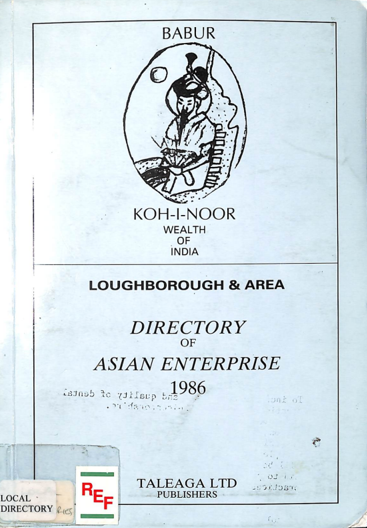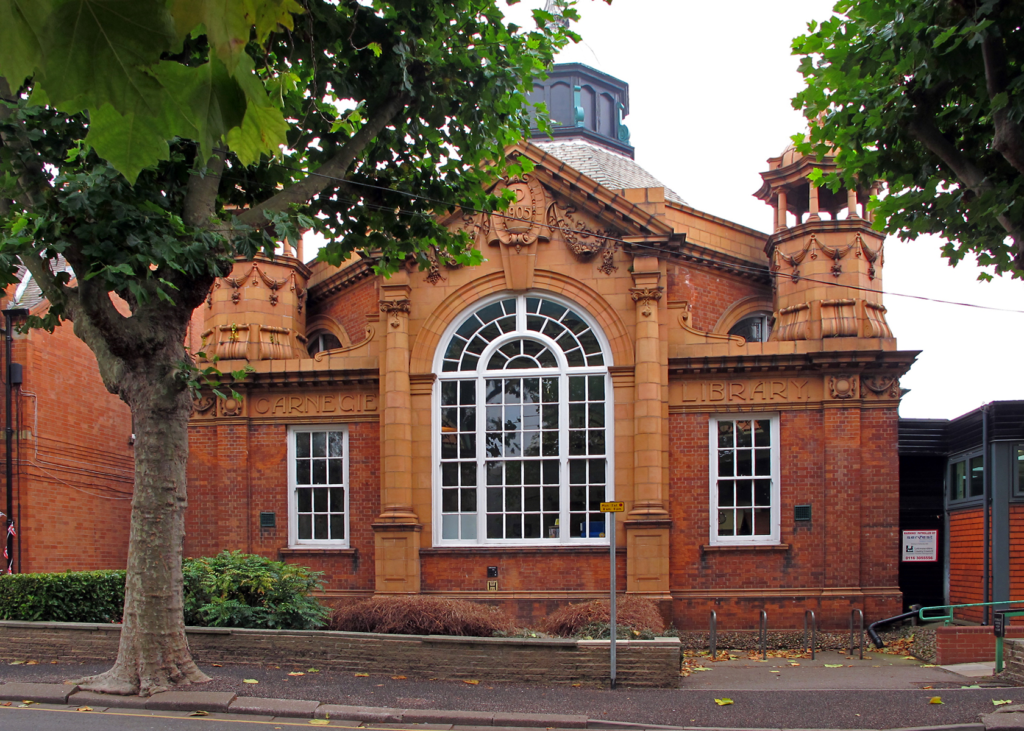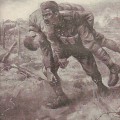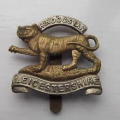Black History Month: brave deeds on the battlefield
23 October 2020
- Postcard showing Rifleman Kulbir Thapa, VC, Queen Alexandra’s Own Gurkha Rifles
- The Leicester Regiment’s Cap Badge. Photo courtesy of Karen Ette.
The February 1915 Parish Magazine of St Peter and St Paul, Syston, contains a letter from local boy Percy Pollard, written to his mother on Christmas Eve 1914:
‘We saw an Indian soldier do a brave deed. He went right out in front of our trenches to get one of our wounded in. He carried him about twenty yards and then got wounded. Then another Indian went out and brought them both safely in. It was worth a VC.’
Percy Pollard went on to see action at Loos in September 1915.
Another Indian soldier who did get a VC was 26-year-old Gurkha Kulbir Thapa who fought in the Second Battallion of the Leicestershires. The Battalion was brought from India to France as the British Battalion of the Garhwal Brigade of the 7th Indian Division and saw action in March 1915 at the Battle of Neuve Chapelle. At the Battle of Loos Gurkha Thapa saved the life of Bill Keightley, a 20-year-old Melton man serving with the 2nd Leicesters. Injured himself, Thapa stumbled across Keightley behind enemy lines and stayed with him for 36 hours before rising mist provided the cover needed to carry him to safety. Thapa became the first Gurkha to receive the Victoria Cross, the Army’s highest award for bravery. He rejoined his battalion on 4 January 1916 at their new posting in Egypt and later achieved the rank of Havildar, equivalent to the rank of Sergeant. His Victoria Cross is displayed at the Gurkha Museum in Winchester.
The role of Indian troops in the First World War has been much debated and is still controversial. In an article for the British Library, Dr Santanu Das discusses race, empire and colonial troops and explores the fragments of historical sources which shed light on the experiences of the one million Indians who fought in World War One.
With many thanks to Karen Ette for the information in this article.
This article was first published here on 20th October 2014.
Discover more:
Read about the role Commonwealth soldiers played throughout WW1 and about the Indian army’s arrival in France.
Find out how local historians pieced together the story of Kulbir Thapa and Bill Keightley.
Read the story of the Loughborough soldier recalled from serving in India to fight in France and who died 100 years ago this month.
Discover the history of the Leicestershire regiment and a site with information on Leicestershire Regiment soldiers during WW1.
Learn more about Black History Month.
Black History Month: Asian Businesses in Loughborough
16 October 2020
October is Black History month and to mark this, we asked Loughborough Library Local Studies Volunteers for stories from their archives which document the lives of Black and Minority Ethnic communities in Loughborough and the Charnwood Area.
Sadly, current restrictions have limited the group’s access to their actual resources in the local studies room at the library, but they’ve sent us a handful of those they can get to on their digital database.
One of these is a ‘Directory of Asian Enterprise,’ published in Loughborough in 1986. It features many well-known businesses that existed at that time in the town and surrounding villages. Those I noted particularly were the Eastern Garden (where I had my first ever curry – I still remember the occasion and how delicious it was!) and Milan Video Hire on Clarence Street (does anyone else remember the days when you hired the machine for the evening as well as the tape?)
Do you have memories of any of the businesses listed in the directory you could share with us? We’d love to hear them and see any photographs you may have of visiting them over time.
We’d also like to learn more about the history of Black and Minority Ethnic communities in Charnwood. Email us if you’d like to help build our bank of stories and commemorate the fantastic diversity of the area in which we live.
Alison Mott

Black History Month: The Martin Brothers
9 October 2020
‘True Patriots Who Did Their Duty’*
Yusef and Benyam Workinah Martin were the sons of Hakim** Workinah Eshete, known to the English by his adoptive name of Charles Workneh Martin. Their father had been found abandoned on an Ethiopian battlefield as a small child and taken by a British army officer to India, where he was brought up and educated. He became the first Ethiopian to qualify as a medical doctor and worked as a civil surgeon in Burma, returning to Ethiopia from time to time before settling more permanently there after the First World War. He was influential in education and government, led a diplomatic delegation to the USA in 1927, was appointed Governor of Chercher province in 1930 and Ethiopian Ambassador to London in July 1935.
Yusef and Benyam were brought up bilingual in English and Amharic. In 1924 their father brought them to England to be schooled and they were admitted to Trent College, where they were known as Joe and Ben. In 1931 they both applied to Loughborough College, Joe to study Commerce (though he eventually chose Mechanical Engineering), and Ben to do Civil Engineering. The Martin brothers boarded in the newly opened Rutland Hall and were keen sportsmen: they both played cricket (Joe was captain in 1935), while Joe also played hockey and Ben rugby.
After Ben got his Diploma in 1935 he and Joe went to London where they acted as assistants to their father in the Ethiopian Legation. In October 1935, however, they returned to Ethiopia to help in their country’s struggle against the invading Italian army. They carried with them over a hundred gas masks. For a time they acted as interpreters to the British Ambulance Service. It was reported that ‘they immediately seized upon the two motor bicycles of the unit and raced round the streets of Addis Ababa to the consternation of the people and to the evident admiration of their friends.’ They were later withdrawn from the BAS for technical work on munitions in Addis Ababa, until ordered by Emperor Haile Selassie to join the forces fighting the Italians in Western Ethiopia. Ben, who was asked to take photos and write articles, implied in a letter to his father that he was the leader of the resistance group the ‘Black Lions’. In May 1936 the Emperor was forced into exile and by December the Martin brothers had no choice but to surrender to the Italians. They were put to work in Italy’s central workshop in Addis Ababa but in the massacre that followed the attempted assassination in February 1937 of the Italian Viceroy, Marshal Graziani, they were arrested at night and summarily shot.
The news of their deaths reached England several months later and was reported in the College Magazine The Limit, which commented: ‘Their friends, besides feeling a sense of personal loss cannot help thinking with regret of the untimely fate of these two, who lived so joyfully, and who could have offered such talents for the benefit of their country.’
Jenny Clark, Loughborough University Archives
* The Limit, July 1938, p.119
** Hakim is the title given to a doctor in Ethiopia
Andrew Carnegie and Loughborough’s Carnegie Library
2 October 2020
Andrew Carnegie (1835–1919) was a Scottish-American industrialist and business magnate. He led the expansion of the American steel industry in the late 19th century and is often identified as having been one of the richest people in history.
During the last 18 years of his life, Carnegie gave away some $350 million (estimated as equivalent to $65 billion in 2019) to charities, foundations and universities, including Carnegie Hall in New York. This amounted to about 90% of his fortune.
Among his many charitable donations, he is known for funding the establishment of thousands of public – or free – libraries throughout the United States, Britain, Canada and other English-speaking countries of the world.
The world’s first free Carnegie Library was opened in Dunfermline, Scotland – Carnegie’s birthplace – in 1883. In 1899 he donated £50,000 towards the foundation of the University of Birmingham.
Loughborough’s Carnegie Library
Loughborough Public Library was built in 1905 as a Carnegie-funded library. The building was then extended in the middle of the 20th century. The new extension was attached to the Carnegie library building which can still be seen today and is protected as a listed building, as is the former librarian’s house which adjoins it to the rear in Packe Street.
The superb domed area in the original Carnegie building, with its magnificent stained-glass windows, today houses the children’s library.
The Local and Family History Centre with an exhibition area, genealogy reading room and local history reference collection is also contained within the original footprint of the Carnegie library and is the home of Loughborough Library Local Studies Volunteers.
Article and research by Loughborough Library Local Studies Volunteers.

As well as financing the building of the Granby Street Library, in 1922 the Carnegie UK Trust was also responsible for funding the Leicestershire County Rural Library under a grant awarded to Loughborough College Principal Herbert Schofield. The Service operated from College premises in Frederick Street until relocating to New Street, Leicester, in 1935.
Email us to share your memories of Loughborough’s Carnegie Library.


